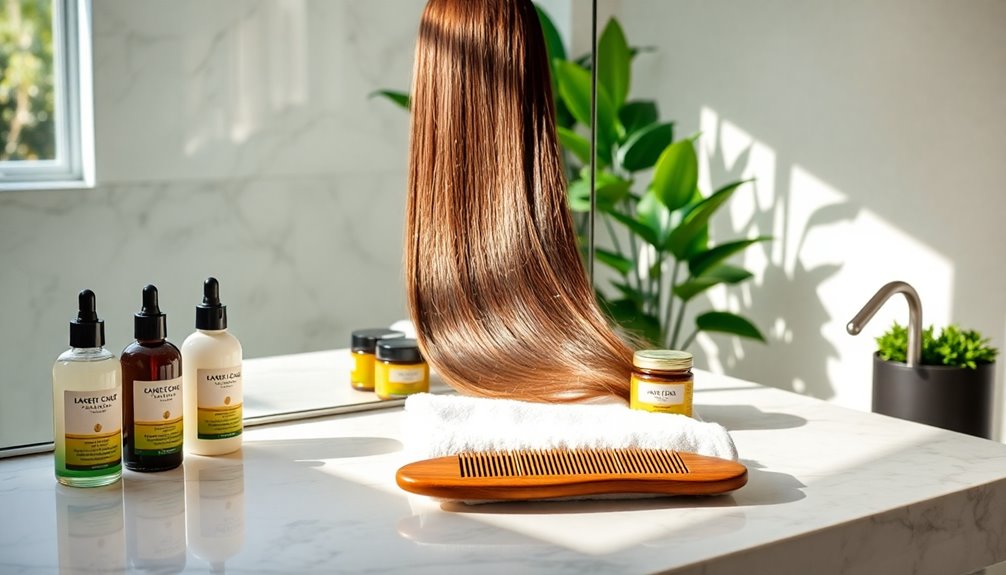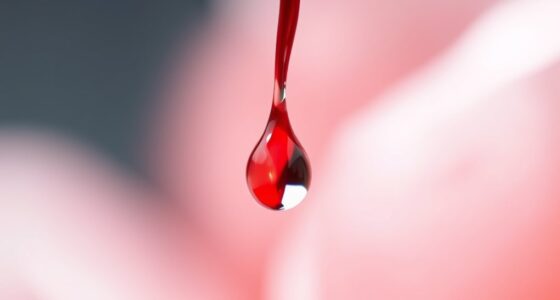If you've got damaged hair, don't panic! Start with a sulfate-free shampoo and limit washes to 2-3 times a week to keep moisture in. Incorporate weekly deep conditioning treatments and use leave-in products for added hydration. Always use a heat protectant when styling and limit heat tools. Protect your hair from environmental stressors with UV sprays and hats. There's so much more you can do to rejuvenate your hair—discover additional tips to restore its health!
Key Takeaways
- Use sulfate-free, moisturizing shampoos and conditioners to nourish and hydrate damaged hair.
- Limit washing to 2-3 times a week to retain natural oils and moisture.
- Incorporate weekly deep conditioning treatments with nourishing ingredients like avocado or coconut oil.
- Apply leave-in conditioners for added hydration and protection against environmental damage.
- Use a wide-tooth comb on wet hair to minimize breakage and avoid over-brushing.
Signs of Damaged Hair

When you notice your hair looking dull and frizzy, it might be time to assess the signs of damage. Common indicators include split ends, increased tangling, and a dry, brittle texture that lacks moisture and shine.
If your hair feels rough or shows noticeable changes in its texture or curl pattern, these are clear signs of damaged hair. You might also be experiencing hair loss and breakage, especially if you have curly hair, where breakage can be particularly visible.
Frequent heat styling, chemical treatments, and rough handling can exacerbate these issues, leading to further breakage and damage. Recognizing these signs early is essential for implementing effective care strategies that can help restore your hair's health and energy.
Common Causes of Hair Damage

You might be surprised to learn that everyday habits can lead to hair damage.
Heat styling tools, chemical treatments, and harsh environmental conditions all contribute to weakened hair.
Understanding these common causes is the first step in effectively caring for your locks.
Heat Styling Damage
How often do you find yourself reaching for heat styling tools to achieve that perfect look? While they can create stunning styles, excessive use leads to heat damage, weakening your hair fibers and increasing brittleness.
When your hair is wet, it's even more vulnerable, making those strands prone to breakage. To protect your hair, always use heat protectants; they form a barrier that minimizes direct heat exposure.
Additionally, try to limit your use of heat styling tools and consider lowering the temperature settings. These simple changes can help you repair damaged hair and maintain its health. It's also important to store essential oils properly, as they can enhance your hair care routine when used correctly.
Chemical Treatments Impact
Although chemical treatments can enhance your hairstyle, they often come with hidden costs that can considerably damage your hair. Treatments like dyeing and bleaching break disulfide bonds, leading to increased dryness, brittleness, and breakage. Frequent exposure to harsh chemicals alters your hair's natural structure, resulting in texture changes and split ends. To combat these effects, bond-building products are essential for restoring your hair's internal structure and improving resilience. Regularly evaluating your hair health post-treatment can prevent untreated damage from escalating. Additionally, incorporating best moisturizing treatments can help to mitigate the drying effects of chemical processes.
| Chemical Treatment | Effects on Hair | Recommended Care |
|---|---|---|
| Dyeing | Weakens strands | Use bond-building products |
| Bleaching | Increases brittleness | Moisturizing treatments |
| Perming | Alters texture | Deep conditioning |
| Relaxing | Causes dryness | Regular trims |
| Highlights | Promotes frizz | Hydrating masks |
Environmental Factors Influence
While many focus on chemical treatments, environmental factors can greatly impact hair health as well. Sun exposure, chlorinated water, and seasonal changes contribute to hair damage, often as much as heat styling tools.
Here are some common culprits you might encounter:
- UV Radiation: It weakens your hair, leading to dryness.
- Chlorinated Water: It strips away natural oils, making hair dry and brittle.
- Cold, Dry Air: It causes moisture loss, resulting in brittleness.
- Humidity: It creates frizz by disrupting your hair's structure.
Being aware of these environmental factors is essential. Protect your hair by rinsing after swimming, using UV protection, and keeping it moisturized, especially during harsh weather. Additionally, maintaining color accuracy in the products you use can help preserve your hair's vibrancy and health.
Regular cleansing is key to maintaining healthy hair.
Essential Hair Care Routine

To effectively care for damaged hair, establishing a gentle hair care routine is essential. Focus on using sulfate-free, moisturizing hair care products designed specifically for damage to the hair. Limit washing to 2-3 times a week to retain moisture and incorporate leave-in conditioners for added hydration.
| Step | Action | Purpose |
|---|---|---|
| Washing | Use lukewarm water | Prevents further damage |
| Drying | Pat hair dry with a cotton T-shirt | Reduces frizz and breakage |
| Conditioning | Apply deep conditioner weekly | Targets signs of damage |
| Trimming | Schedule trims every 6-8 weeks | Maintains healthy hair |
Deep Conditioning Treatments

If you want to revive your damaged hair and restore its natural beauty, incorporating deep conditioning treatments into your routine is a must.
These treatments are essential for replenishing moisture and repairing your hair's internal structure. Aim to use them at least once a week, leaving the product in for 10-15 minutes for maximum absorption.
Incorporate deep conditioning treatments weekly for optimal moisture replenishment and hair repair. Leave in for 10-15 minutes for best results.
Look for masks that target split ends and dryness, and consider ingredients known for their nourishing properties, such as:
- Avocado
- Honey
- Coconut oil
- Collagen peptides
With consistent use of deep conditioning treatments, you'll notice smoother, stronger hair that's easier to manage. Additionally, using products with natural ingredients can enhance the overall health of your hair.
Say goodbye to frizz and hello to vibrant, healthy locks!
Proper Washing and Drying Techniques
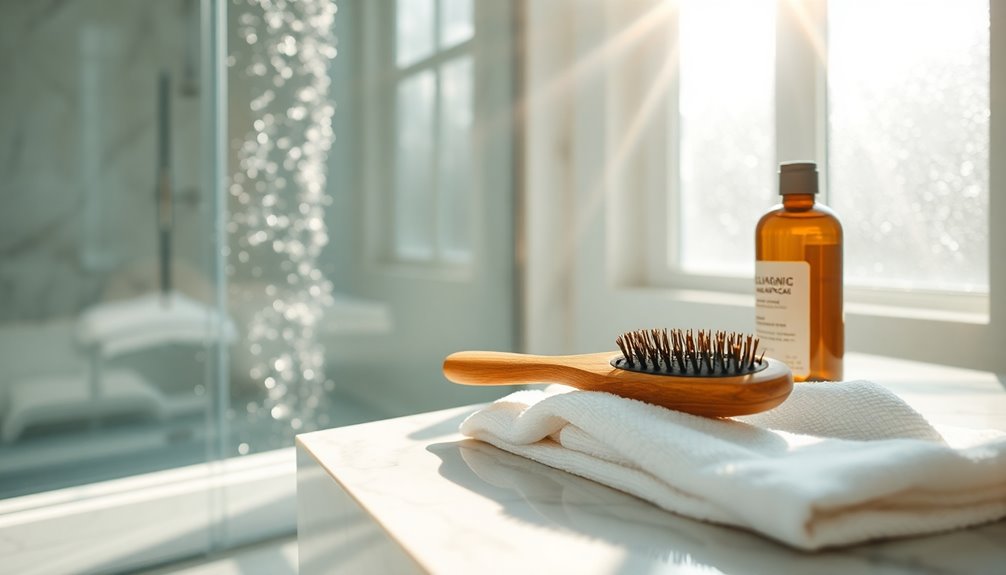
Proper washing and drying techniques are essential for maintaining the health of your damaged hair.
Start by using lukewarm water to wash your hair; this helps preserve moisture and prevent damage to the cuticle. Limit your washes to 2-3 times per week to retain the natural oils that protect against dryness.
When it's time to dry, gently pat your hair with a cotton T-shirt or microfiber towel instead of rubbing it vigorously with a regular towel, as this minimizes friction and breakage. Allow your hair to air dry whenever possible to reduce heat damage.
Finally, always rinse your conditioner with cool water to seal the cuticle and enhance shine. These steps can considerably improve your hair's condition!
Brushing and Combing Best Practices
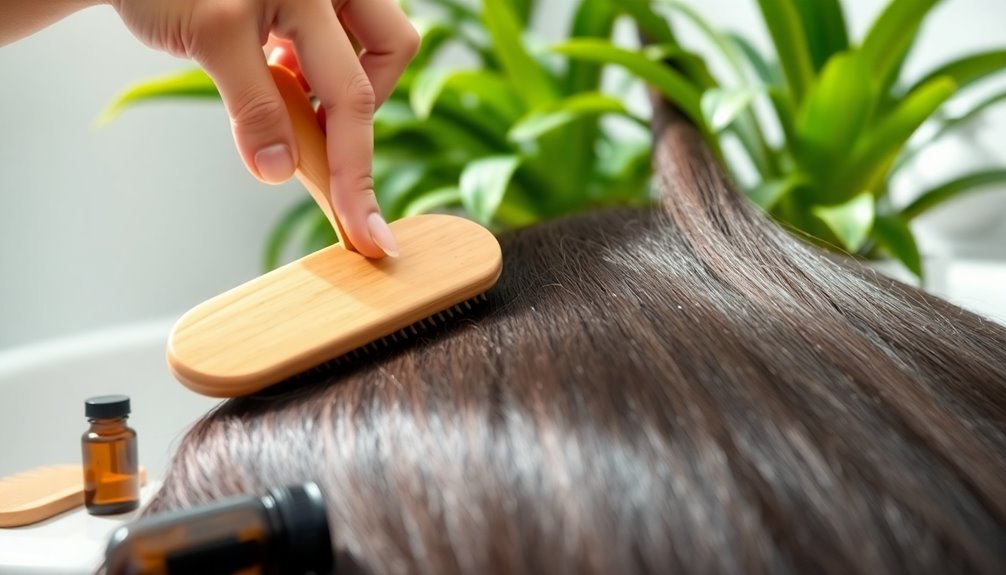
When it comes to brushing and combing your hair, using the right tools makes all the difference.
A wide-tooth comb is your best friend for gently detangling wet hair without causing breakage.
Gentle Detangling Techniques
Caring for damaged hair starts with gentle detangling techniques that prevent further harm. Use a wide-tooth comb on wet hair to minimize breakage, as it's more fragile when damp.
Start detangling from the ends and work your way up to the roots, avoiding over-brushing that can cause mechanical damage.
Consider these tips to make detangling easier:
- Apply a detangling spray or leave-in conditioner to reduce friction.
- Schedule regular trims every 6-8 weeks to manage split ends.
- Use a wide-tooth comb to gently remove knots without pulling.
- Sleep on silk or satin pillowcases to reduce tangling and breakage.
With these strategies, you'll keep your hair healthy and looking great!
Choosing the Right Tools
Choosing the right tools for brushing and combing can make a significant difference in how you care for damaged hair. Start by using a wide-tooth comb on wet hair to gently detangle, as this minimizes breakage.
To make the process easier, apply a detangling spray or leave-in conditioner for added moisture, reducing friction. Remember, avoid over-brushing; excessive brushing can lead to split ends and hair loss.
Additionally, schedule regular trims every 6-8 weeks to remove split ends and promote healthy growth. Using sulfate-free options in your hair care routine can further help in maintaining moisture and preventing damage.
At night, protect your hair by sleeping on silk or satin pillowcases, which help reduce friction and prevent tangling.
With these practices, your damaged hair will look and feel healthier in no time!
Heat Styling Tips for Healthy Hair

While heat styling can help you achieve your desired look, it's essential to do so wisely to prevent damage. Here are some important heat styling tips to keep your hair healthy:
- Limit heat styling to once or twice a week.
- Always apply a heat protectant spray before using styling tools; it can reduce heat exposure by up to 50%.
- Use lower heat settings, ideally below 350°F, to minimize damage.
- Incorporate heat-free styling methods, like braiding damp hair or using rollers.
Don't forget to regularly use deep conditioning treatments to replenish moisture and repair damage.
Prioritizing these practices won't only enhance your style but also promote the long-term health of your hair.
Environmental Protection for Hair
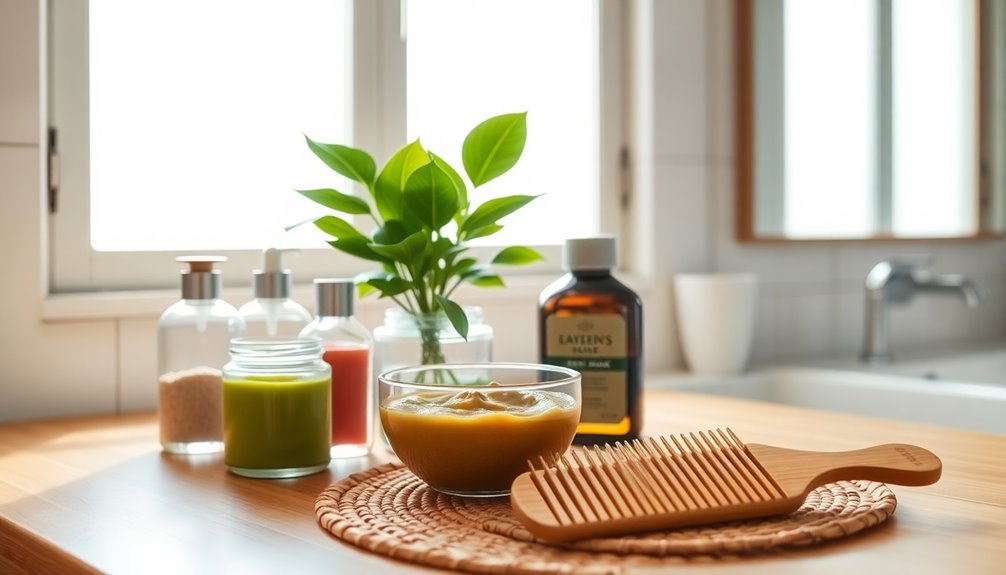
Environmental factors can greatly impact the health of your hair, so taking proactive steps to protect it's essential.
To shield your strands from environmental damage, wear hats or scarves during harsh weather. This prevents dryness and breakage caused by wind and cold temperatures.
Excessive sun exposure can dehydrate your hair and fade its color, so using UV protection sprays is vital for maintaining vibrancy and moisture.
After swimming in chlorinated or salty water, rinse your hair with fresh water to remove harmful chemicals.
Incorporating hair care products with antioxidants combats pollution and environmental stressors, preserving your hair's health and shine.
Regularly assess your hair's condition to identify any impacts and adjust your care routine accordingly.
Professional Help for Severe Damage

Even with your best efforts to shield your hair from environmental harm, severe damage can still occur. When this happens, seeking professional help is essential.
A skilled stylist can assess the extent of damage and recommend tailored treatments that at-home products simply can't provide.
Consider these options for recovery:
- Bond-building services to restore hair structure
- Regular trims every 6-8 weeks to manage split ends
- Protein treatments for deep repair
- Deep conditioning services for added moisture
Experienced colorists can also help maintain hair integrity during color changes, preventing further damage.
Regular visits guarantee you address severe damage effectively, allowing your hair to regain its strength and shine.
Frequently Asked Questions
How Can I Treat Severely Damaged Hair at Home?
To treat severely damaged hair at home, start by incorporating a deep conditioning treatment once a week.
Look for products with proteins and collagen peptides.
Limit washing to 2-3 times a week with a sulfate-free, moisturizing shampoo to keep your natural oils intact.
After washing, apply a leave-in conditioner for extra hydration.
Don't forget to trim your hair every 6-8 weeks to remove split ends and promote healthier growth.
How to Repair Damaged Hair Asap?
To repair damaged hair ASAP, start with bond-repairing products that strengthen your hair's structure.
Use deep conditioning treatments weekly, leaving them on for 10-15 minutes. Limit washing to 2-3 times a week with a sulfate-free shampoo, and rinse your conditioner with cool water.
Detangle gently with a wide-tooth comb on wet hair, and apply a leave-in conditioner for extra hydration.
Regular trims every 6-8 weeks will help manage split ends and promote healthy growth.
How Can I Bring My Damaged Hair Back to Life?
Imagine your hair as a wilting flower, yearning for revival. You can bring your damaged hair back to life by using bond-repairing products regularly to strengthen and smooth it.
Incorporate deep conditioning treatments packed with proteins into your weekly routine, and limit washing to just 2-3 times a week.
Don't forget regular trims to snip away split ends, and always use heat protectants when styling to safeguard your delicate strands.
What Is the Best Product to Repair Damaged Hair?
The best product to repair damaged hair often depends on your specific needs.
You might want to try bond-building treatments like Olaplex No. 7 or K18 Leave-In Mask, as they effectively restore hair structure.
Deep conditioning treatments with proteins can strengthen and enhance texture, while sulfate-free shampoos nourish without stripping oils.
Don't forget a leave-in conditioner to add hydration and reduce frizz, and always use a heat protectant when styling!
Conclusion
So, it turns out that your hair doesn't actually love frequent dye jobs and relentless heat styling—who knew? By embracing the simple care tips we discussed, you can transform your damaged locks into a healthy mane. It's almost like your hair wants to thrive without the constant torture of products and tools. So, give it the love it deserves at home, and watch it bounce back to life. Who knew healthy hair could be so easy?
